Child and Young Person Development: Factors and Theories Report
VerifiedAdded on 2020/06/04
|33
|9108
|49
Report
AI Summary
This report delves into the multifaceted realm of child and young person development. It begins by outlining the sequence and rate of various developmental aspects from birth, providing a detailed timeline of physical, intellectual, language, emotional, social, and moral development across different age ranges. The report then contrasts the sequence and rate of development, emphasizing their importance in assessing normal development and identifying potential concerns. Furthermore, it explores the influence of personal and external factors on a child's growth, including genetic information and environmental impacts. The report also covers theories of development, methods for monitoring progress, the effects of disabilities, and various intervention strategies designed to promote healthy development. Finally, it addresses the importance of understanding these factors to provide effective support and interventions for children and young people.
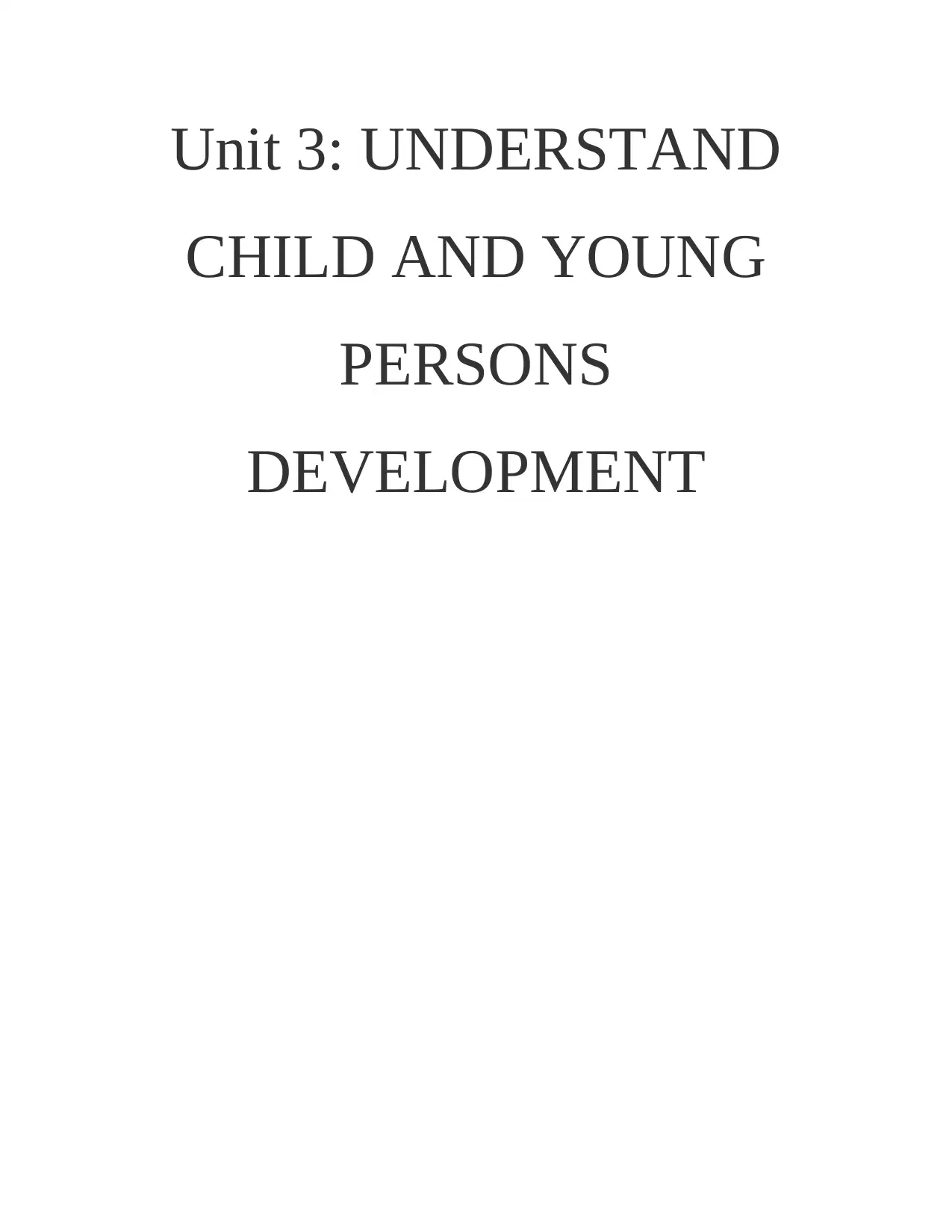
Unit 3: UNDERSTAND
CHILD AND YOUNG
PERSONS
DEVELOPMENT
CHILD AND YOUNG
PERSONS
DEVELOPMENT
Paraphrase This Document
Need a fresh take? Get an instant paraphrase of this document with our AI Paraphraser
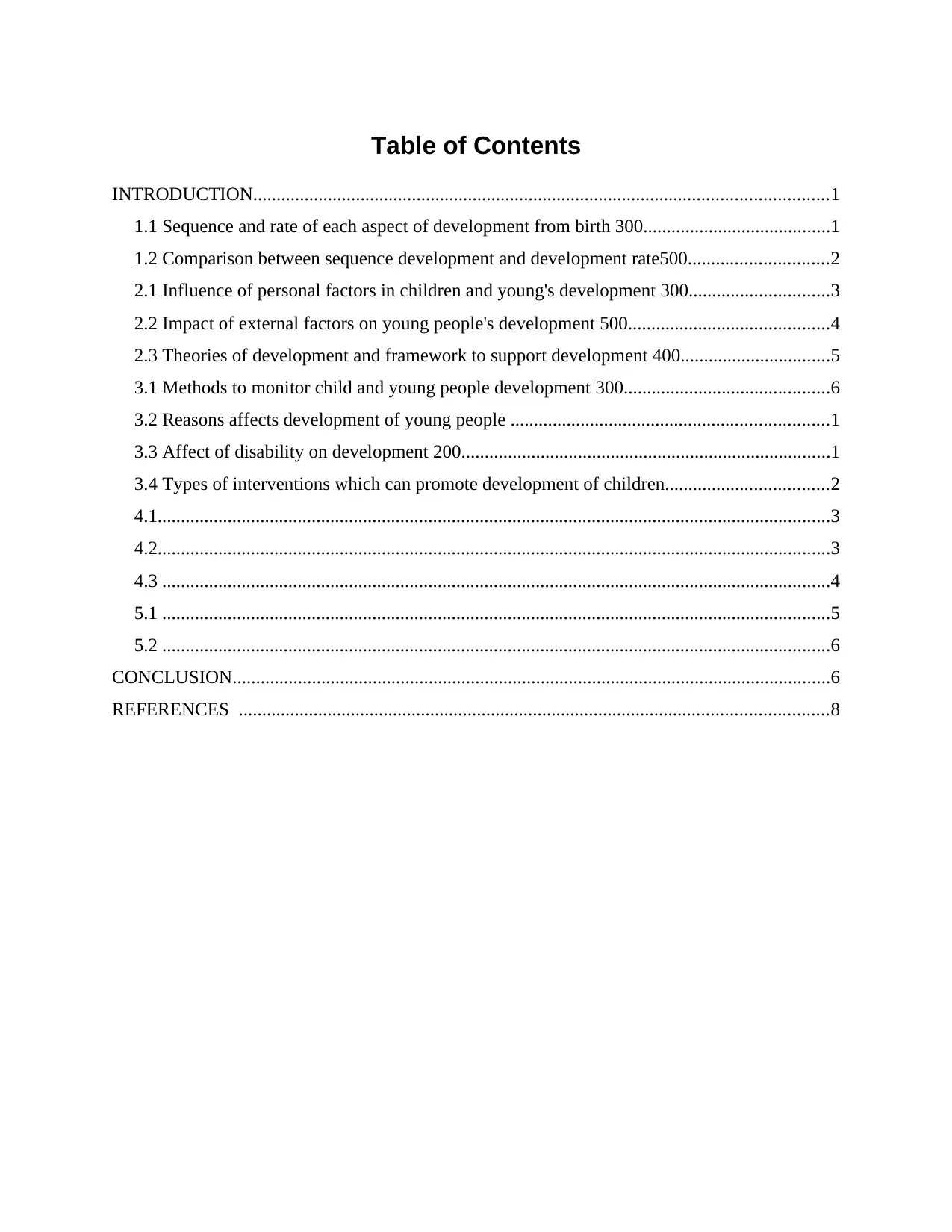
Table of Contents
INTRODUCTION...........................................................................................................................1
1.1 Sequence and rate of each aspect of development from birth 300........................................1
1.2 Comparison between sequence development and development rate500..............................2
2.1 Influence of personal factors in children and young's development 300..............................3
2.2 Impact of external factors on young people's development 500...........................................4
2.3 Theories of development and framework to support development 400................................5
3.1 Methods to monitor child and young people development 300............................................6
3.2 Reasons affects development of young people ....................................................................1
3.3 Affect of disability on development 200...............................................................................1
3.4 Types of interventions which can promote development of children...................................2
4.1................................................................................................................................................3
4.2................................................................................................................................................3
4.3 ...............................................................................................................................................4
5.1 ...............................................................................................................................................5
5.2 ...............................................................................................................................................6
CONCLUSION................................................................................................................................6
REFERENCES ..............................................................................................................................8
INTRODUCTION...........................................................................................................................1
1.1 Sequence and rate of each aspect of development from birth 300........................................1
1.2 Comparison between sequence development and development rate500..............................2
2.1 Influence of personal factors in children and young's development 300..............................3
2.2 Impact of external factors on young people's development 500...........................................4
2.3 Theories of development and framework to support development 400................................5
3.1 Methods to monitor child and young people development 300............................................6
3.2 Reasons affects development of young people ....................................................................1
3.3 Affect of disability on development 200...............................................................................1
3.4 Types of interventions which can promote development of children...................................2
4.1................................................................................................................................................3
4.2................................................................................................................................................3
4.3 ...............................................................................................................................................4
5.1 ...............................................................................................................................................5
5.2 ...............................................................................................................................................6
CONCLUSION................................................................................................................................6
REFERENCES ..............................................................................................................................8
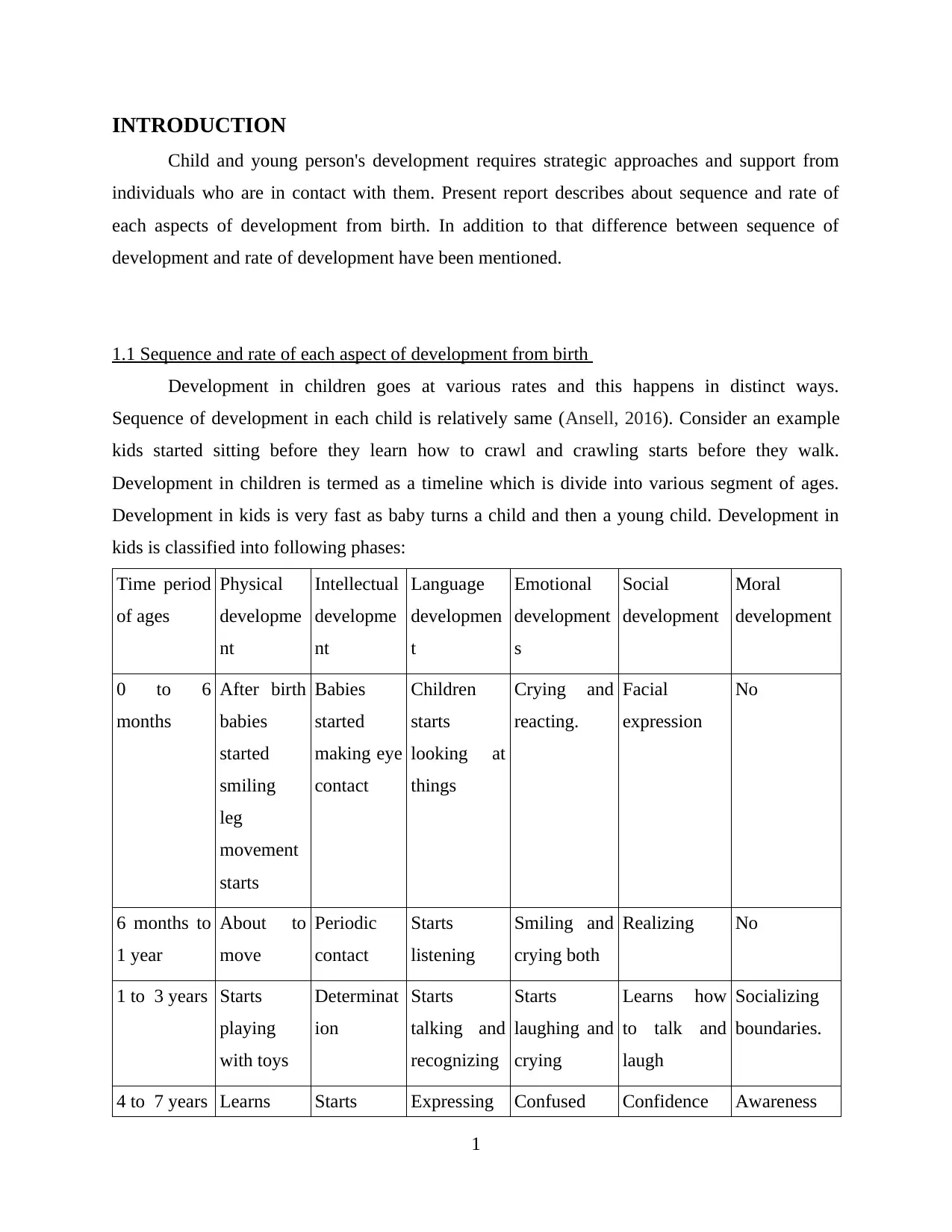
INTRODUCTION
Child and young person's development requires strategic approaches and support from
individuals who are in contact with them. Present report describes about sequence and rate of
each aspects of development from birth. In addition to that difference between sequence of
development and rate of development have been mentioned.
1.1 Sequence and rate of each aspect of development from birth
Development in children goes at various rates and this happens in distinct ways.
Sequence of development in each child is relatively same (Ansell, 2016). Consider an example
kids started sitting before they learn how to crawl and crawling starts before they walk.
Development in children is termed as a timeline which is divide into various segment of ages.
Development in kids is very fast as baby turns a child and then a young child. Development in
kids is classified into following phases:
Time period
of ages
Physical
developme
nt
Intellectual
developme
nt
Language
developmen
t
Emotional
development
s
Social
development
Moral
development
0 to 6
months
After birth
babies
started
smiling
leg
movement
starts
Babies
started
making eye
contact
Children
starts
looking at
things
Crying and
reacting.
Facial
expression
No
6 months to
1 year
About to
move
Periodic
contact
Starts
listening
Smiling and
crying both
Realizing No
1 to 3 years Starts
playing
with toys
Determinat
ion
Starts
talking and
recognizing
Starts
laughing and
crying
Learns how
to talk and
laugh
Socializing
boundaries.
4 to 7 years Learns Starts Expressing Confused Confidence Awareness
1
Child and young person's development requires strategic approaches and support from
individuals who are in contact with them. Present report describes about sequence and rate of
each aspects of development from birth. In addition to that difference between sequence of
development and rate of development have been mentioned.
1.1 Sequence and rate of each aspect of development from birth
Development in children goes at various rates and this happens in distinct ways.
Sequence of development in each child is relatively same (Ansell, 2016). Consider an example
kids started sitting before they learn how to crawl and crawling starts before they walk.
Development in children is termed as a timeline which is divide into various segment of ages.
Development in kids is very fast as baby turns a child and then a young child. Development in
kids is classified into following phases:
Time period
of ages
Physical
developme
nt
Intellectual
developme
nt
Language
developmen
t
Emotional
development
s
Social
development
Moral
development
0 to 6
months
After birth
babies
started
smiling
leg
movement
starts
Babies
started
making eye
contact
Children
starts
looking at
things
Crying and
reacting.
Facial
expression
No
6 months to
1 year
About to
move
Periodic
contact
Starts
listening
Smiling and
crying both
Realizing No
1 to 3 years Starts
playing
with toys
Determinat
ion
Starts
talking and
recognizing
Starts
laughing and
crying
Learns how
to talk and
laugh
Socializing
boundaries.
4 to 7 years Learns Starts Expressing Confused Confidence Awareness
1
⊘ This is a preview!⊘
Do you want full access?
Subscribe today to unlock all pages.

Trusted by 1+ million students worldwide

coordinatin
g with
people
writing and
reading
through oral
modes
and
sometime
about things
building about
himself/
herself.
8 to 12
years
Strength
and
growths
Start
preferring
thinking
Fluency in
speaking.
Aggressive
and crying
Talks in
groups
Self
administratio
n is started
and moral
development
initiates.
13 to 19
years
Matured
and adult
More focus
on strength
Starts taking
decision
about future
Nervousness
and
responsible
Active and
starts
discussing in
society with
confidence
Generic with
adultness
Strength and co-ordination develops greatly between age of 13 to 19 years. Strength increasing
can be measured by voice changing and development in bones. Development in language
generally begins in first three months after birth.
0 to 6 months
Physical development
Smiling
Moving legs
Unfolding hands
Observing colors Eyes move in unison
Intellectual development
Getting familiar with routine
Controlling and stabilizing head movements
2
g with
people
writing and
reading
through oral
modes
and
sometime
about things
building about
himself/
herself.
8 to 12
years
Strength
and
growths
Start
preferring
thinking
Fluency in
speaking.
Aggressive
and crying
Talks in
groups
Self
administratio
n is started
and moral
development
initiates.
13 to 19
years
Matured
and adult
More focus
on strength
Starts taking
decision
about future
Nervousness
and
responsible
Active and
starts
discussing in
society with
confidence
Generic with
adultness
Strength and co-ordination develops greatly between age of 13 to 19 years. Strength increasing
can be measured by voice changing and development in bones. Development in language
generally begins in first three months after birth.
0 to 6 months
Physical development
Smiling
Moving legs
Unfolding hands
Observing colors Eyes move in unison
Intellectual development
Getting familiar with routine
Controlling and stabilizing head movements
2
Paraphrase This Document
Need a fresh take? Get an instant paraphrase of this document with our AI Paraphraser
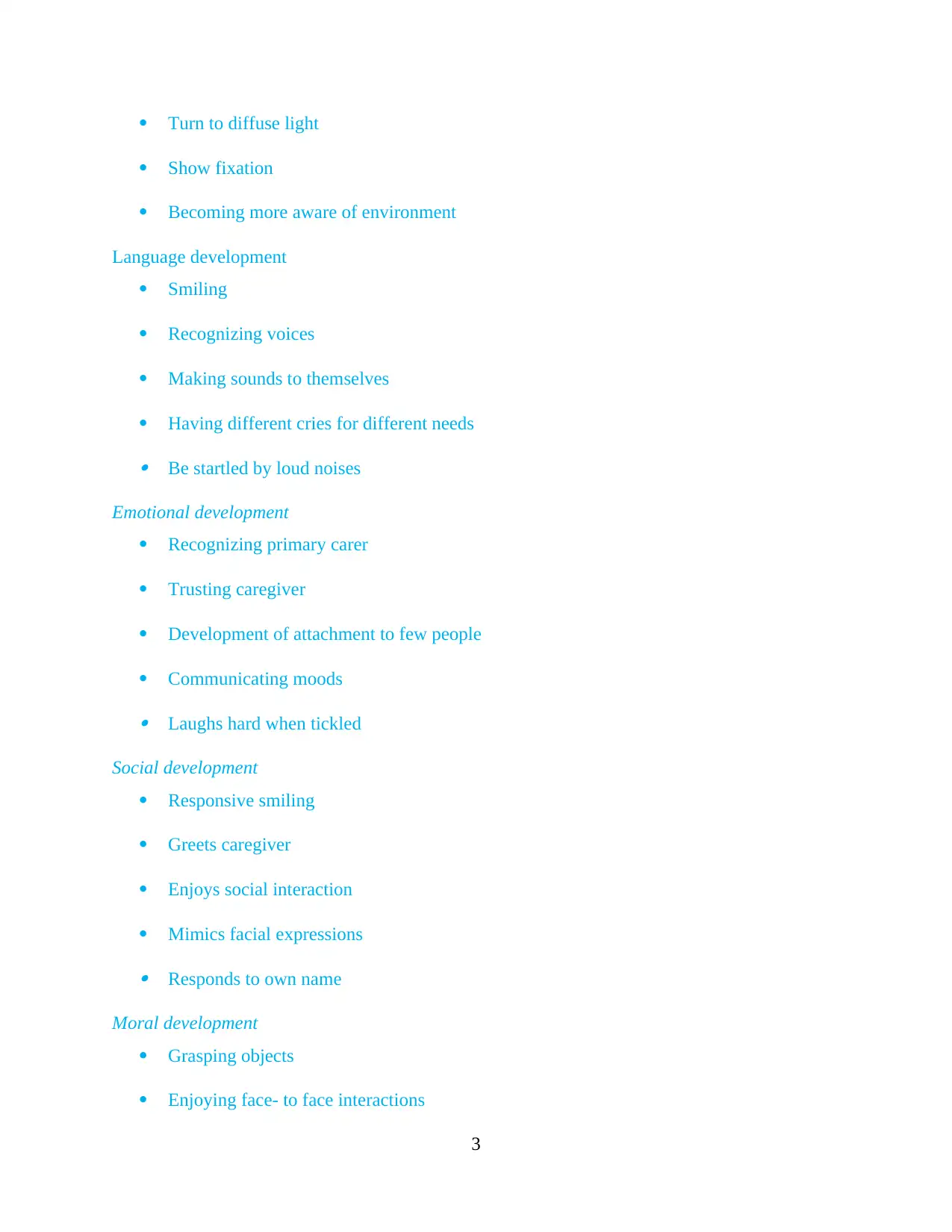
Turn to diffuse light
Show fixation
Becoming more aware of environment
Language development
Smiling
Recognizing voices
Making sounds to themselves
Having different cries for different needs Be startled by loud noises
Emotional development
Recognizing primary carer
Trusting caregiver
Development of attachment to few people
Communicating moods Laughs hard when tickled
Social development
Responsive smiling
Greets caregiver
Enjoys social interaction
Mimics facial expressions Responds to own name
Moral development
Grasping objects
Enjoying face- to face interactions
3
Show fixation
Becoming more aware of environment
Language development
Smiling
Recognizing voices
Making sounds to themselves
Having different cries for different needs Be startled by loud noises
Emotional development
Recognizing primary carer
Trusting caregiver
Development of attachment to few people
Communicating moods Laughs hard when tickled
Social development
Responsive smiling
Greets caregiver
Enjoys social interaction
Mimics facial expressions Responds to own name
Moral development
Grasping objects
Enjoying face- to face interactions
3
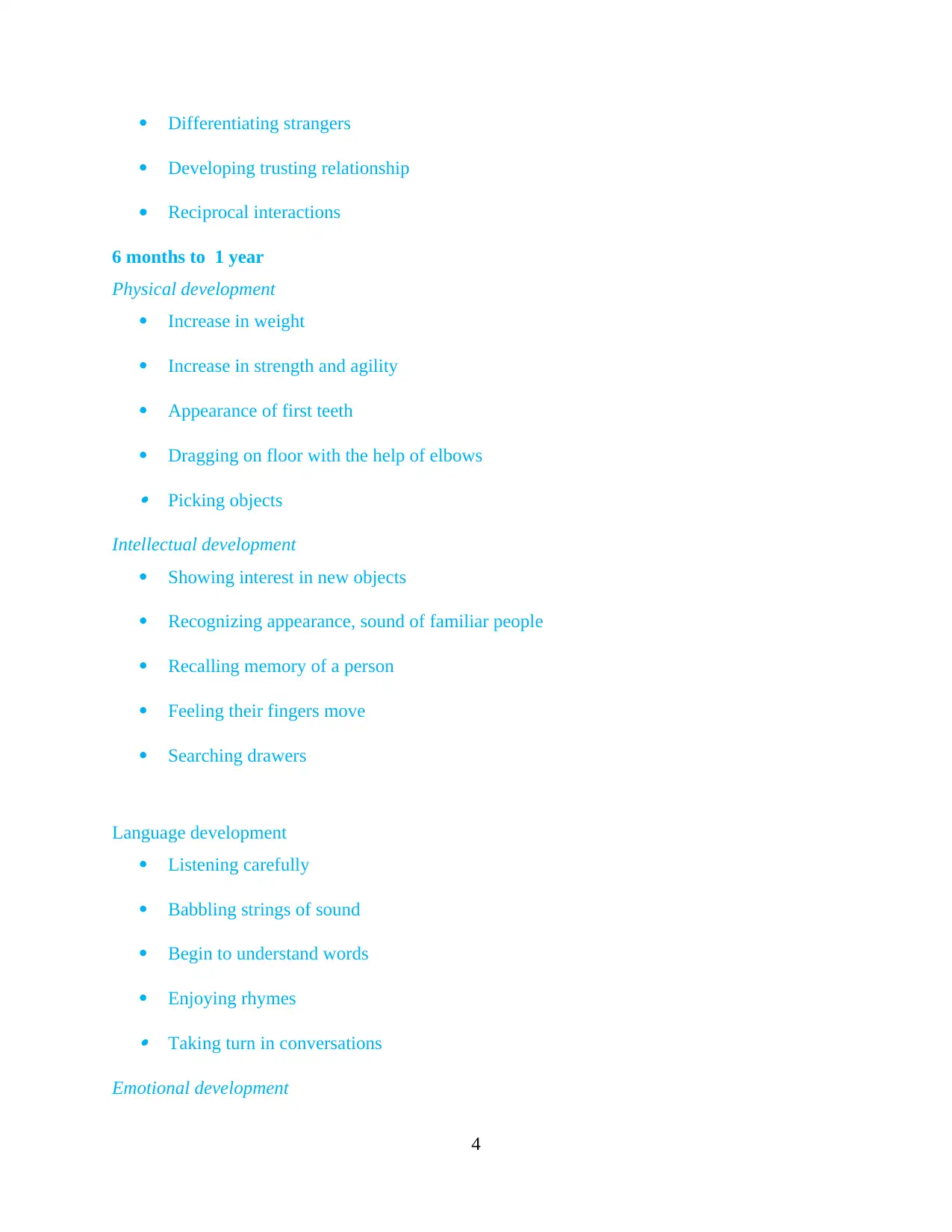
Differentiating strangers
Developing trusting relationship
Reciprocal interactions
6 months to 1 year
Physical development
Increase in weight
Increase in strength and agility
Appearance of first teeth
Dragging on floor with the help of elbows Picking objects
Intellectual development
Showing interest in new objects
Recognizing appearance, sound of familiar people
Recalling memory of a person
Feeling their fingers move
Searching drawers
Language development
Listening carefully
Babbling strings of sound
Begin to understand words
Enjoying rhymes Taking turn in conversations
Emotional development
4
Developing trusting relationship
Reciprocal interactions
6 months to 1 year
Physical development
Increase in weight
Increase in strength and agility
Appearance of first teeth
Dragging on floor with the help of elbows Picking objects
Intellectual development
Showing interest in new objects
Recognizing appearance, sound of familiar people
Recalling memory of a person
Feeling their fingers move
Searching drawers
Language development
Listening carefully
Babbling strings of sound
Begin to understand words
Enjoying rhymes Taking turn in conversations
Emotional development
4
⊘ This is a preview!⊘
Do you want full access?
Subscribe today to unlock all pages.

Trusted by 1+ million students worldwide

Expressing several clear emotions
Showing displeasure when a toy is taken from them
Showing comfort around familiar people
Respond by turning Giving affection and love
Social development
Developing stranger wariness
Developing powerful bond with the parents
Developing marked preference for loved ones
Reacting strongly on absence of caregivers Showing interest in exploring the world around them
Moral development
Wanting to be involved in the family activities
Prefer the caregiver to be always in their sight
Responding to their environment
Showing joy by smiling
Learning to make choices
1 to 3 years
Physical development
Building a tower
Climbing up on low furniture
Scribbling on paper
Getting up off the floor without any help Running in a direction with accuracy
5
Showing displeasure when a toy is taken from them
Showing comfort around familiar people
Respond by turning Giving affection and love
Social development
Developing stranger wariness
Developing powerful bond with the parents
Developing marked preference for loved ones
Reacting strongly on absence of caregivers Showing interest in exploring the world around them
Moral development
Wanting to be involved in the family activities
Prefer the caregiver to be always in their sight
Responding to their environment
Showing joy by smiling
Learning to make choices
1 to 3 years
Physical development
Building a tower
Climbing up on low furniture
Scribbling on paper
Getting up off the floor without any help Running in a direction with accuracy
5
Paraphrase This Document
Need a fresh take? Get an instant paraphrase of this document with our AI Paraphraser
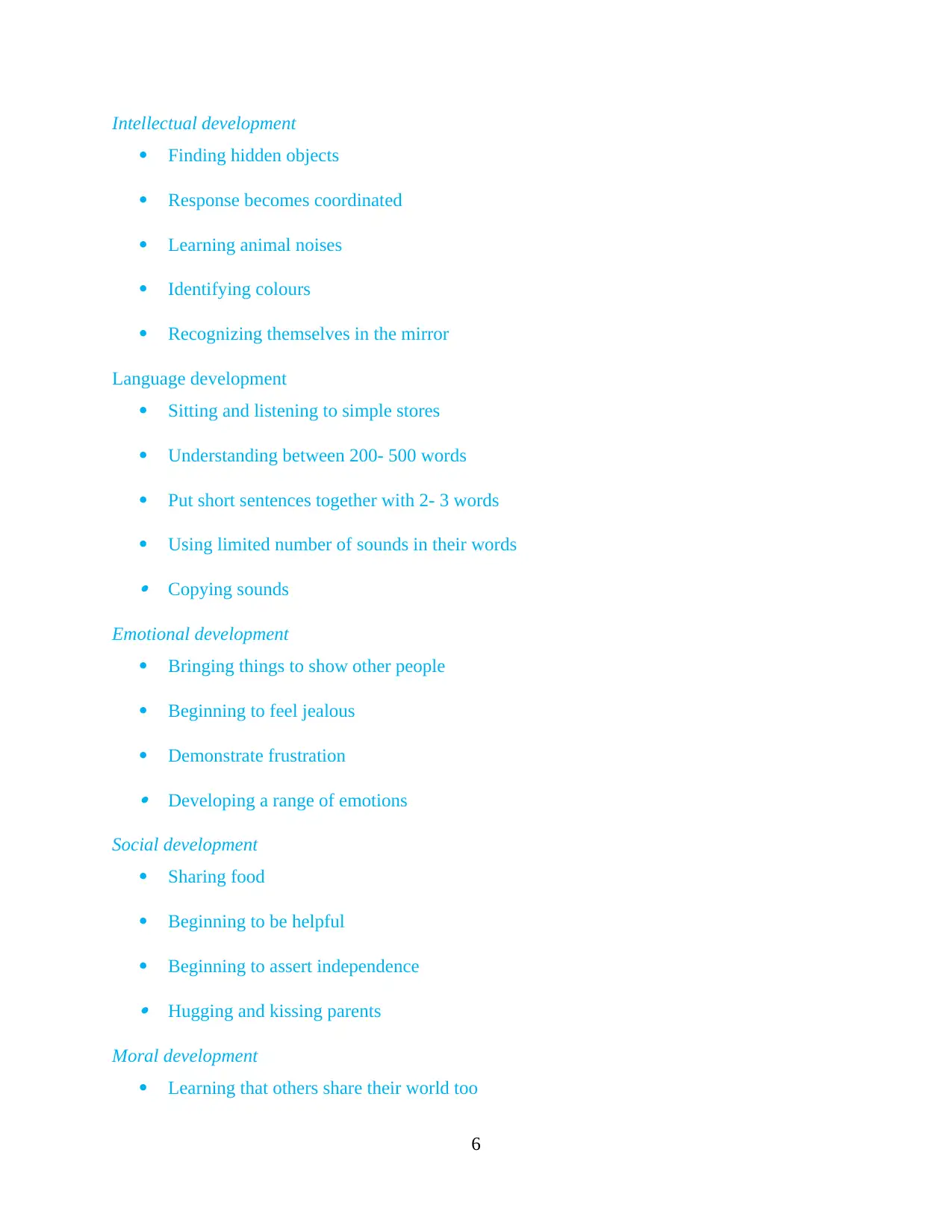
Intellectual development
Finding hidden objects
Response becomes coordinated
Learning animal noises
Identifying colours
Recognizing themselves in the mirror
Language development
Sitting and listening to simple stores
Understanding between 200- 500 words
Put short sentences together with 2- 3 words
Using limited number of sounds in their words Copying sounds
Emotional development
Bringing things to show other people
Beginning to feel jealous
Demonstrate frustration Developing a range of emotions
Social development
Sharing food
Beginning to be helpful
Beginning to assert independence Hugging and kissing parents
Moral development
Learning that others share their world too
6
Finding hidden objects
Response becomes coordinated
Learning animal noises
Identifying colours
Recognizing themselves in the mirror
Language development
Sitting and listening to simple stores
Understanding between 200- 500 words
Put short sentences together with 2- 3 words
Using limited number of sounds in their words Copying sounds
Emotional development
Bringing things to show other people
Beginning to feel jealous
Demonstrate frustration Developing a range of emotions
Social development
Sharing food
Beginning to be helpful
Beginning to assert independence Hugging and kissing parents
Moral development
Learning that others share their world too
6

Learning to make choices in response to punishment
Developing empathy
Respond to help other when they are in need
4 to 7 years
Physical development
Learning to coordinate with people
Holding pencil with correct grip
Rolling and bouncing a ball
Balancing to walk Running on tip toes
Intellectual development
Enjoys dramatic play
Classifies objects by purpose
Understands the order of routine tasks
Understands ideas like opposites
Attaches words to numbers
Language development
Ask and answers
Recognizes some letters and words
Makes use of regular past tense form
Enjoys books, simple songs Uses plurals and pronouns
Emotional development
Showing more independence
7
Developing empathy
Respond to help other when they are in need
4 to 7 years
Physical development
Learning to coordinate with people
Holding pencil with correct grip
Rolling and bouncing a ball
Balancing to walk Running on tip toes
Intellectual development
Enjoys dramatic play
Classifies objects by purpose
Understands the order of routine tasks
Understands ideas like opposites
Attaches words to numbers
Language development
Ask and answers
Recognizes some letters and words
Makes use of regular past tense form
Enjoys books, simple songs Uses plurals and pronouns
Emotional development
Showing more independence
7
⊘ This is a preview!⊘
Do you want full access?
Subscribe today to unlock all pages.

Trusted by 1+ million students worldwide

Experiencing excitement, fear happiness
Being more even tempered Showing attachment to one friend
Social development
Sharing toys
Being bossy and defiant
Developing friendships
Expressing awareness of other people’s feelings Listening to others as they speak
Moral development
Beginning to internalize family values
Understanding then roles of child and adults
Perceiving consequences
8 to 12 years
Physical development
Child begins to appear slimmer
Being able to Jump and skip
Increase in strength Puberty characterized by growth spur like breast development in girls and enlarged testes
in boys
Intellectual development
Understanding reversibility
Beginning to make logical arguments
Increase in problem solving strategies
8
Being more even tempered Showing attachment to one friend
Social development
Sharing toys
Being bossy and defiant
Developing friendships
Expressing awareness of other people’s feelings Listening to others as they speak
Moral development
Beginning to internalize family values
Understanding then roles of child and adults
Perceiving consequences
8 to 12 years
Physical development
Child begins to appear slimmer
Being able to Jump and skip
Increase in strength Puberty characterized by growth spur like breast development in girls and enlarged testes
in boys
Intellectual development
Understanding reversibility
Beginning to make logical arguments
Increase in problem solving strategies
8
Paraphrase This Document
Need a fresh take? Get an instant paraphrase of this document with our AI Paraphraser

Mentally combine, separate and order objects
Language development
Using language for predicting and drawing conclusions
Understanding comparative words
Beginning conversations with adults and children’ Understanding and using passive sentences
Emotional development
Changing emotions quickly
Expressing subtle emotions Becoming quite sensitive
Social development
Developing sportsmanship
Developing competence
Spending time talking to others Developing their own point of view
Moral development
Honesty
Loyalty
Demonstrating the acts of kindness
13 to 19 years
Physical development
Rapid physical development
Development of primary sex characteristics
Development of secondary sex characteristics
9
Language development
Using language for predicting and drawing conclusions
Understanding comparative words
Beginning conversations with adults and children’ Understanding and using passive sentences
Emotional development
Changing emotions quickly
Expressing subtle emotions Becoming quite sensitive
Social development
Developing sportsmanship
Developing competence
Spending time talking to others Developing their own point of view
Moral development
Honesty
Loyalty
Demonstrating the acts of kindness
13 to 19 years
Physical development
Rapid physical development
Development of primary sex characteristics
Development of secondary sex characteristics
9

Enhancement of height
Language development
Use longer sentences
Use of more witty and subtle humour
Understanding and sue of slang terms
Understanding of idioms Use of sarcasm
Emotional development
Dramatic mood swings
Emotional conflicts
Gaining comfort in their own skin
Know how to deal with uncomfortable feelings Enjoy to look back on their achievements
Social development
Develop strong bonds with friends
Engage in conflicts with parents
Interested in developing relationships
Value committed relationships Develop community consciousness
Moral development
Recognize individuals norms
Recognize cultural norms
Form moral values
10
Language development
Use longer sentences
Use of more witty and subtle humour
Understanding and sue of slang terms
Understanding of idioms Use of sarcasm
Emotional development
Dramatic mood swings
Emotional conflicts
Gaining comfort in their own skin
Know how to deal with uncomfortable feelings Enjoy to look back on their achievements
Social development
Develop strong bonds with friends
Engage in conflicts with parents
Interested in developing relationships
Value committed relationships Develop community consciousness
Moral development
Recognize individuals norms
Recognize cultural norms
Form moral values
10
⊘ This is a preview!⊘
Do you want full access?
Subscribe today to unlock all pages.

Trusted by 1+ million students worldwide
1 out of 33
Related Documents
Your All-in-One AI-Powered Toolkit for Academic Success.
+13062052269
info@desklib.com
Available 24*7 on WhatsApp / Email
![[object Object]](/_next/static/media/star-bottom.7253800d.svg)
Unlock your academic potential
Copyright © 2020–2025 A2Z Services. All Rights Reserved. Developed and managed by ZUCOL.





